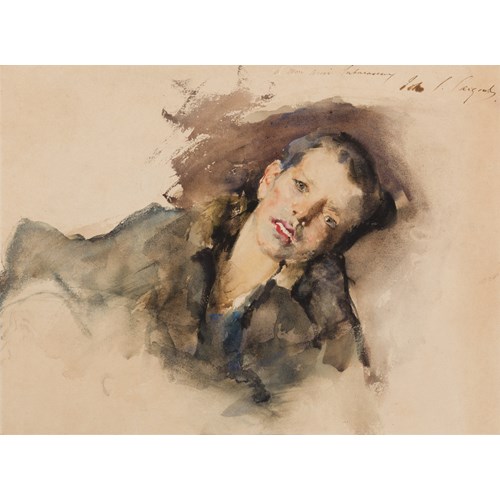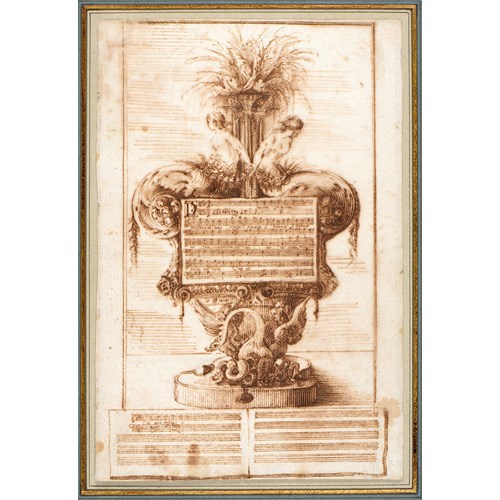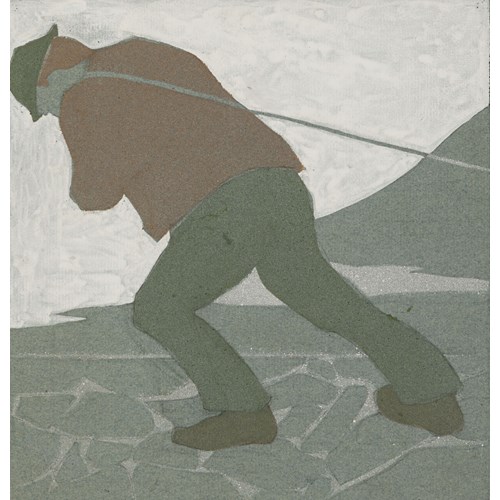Giulio Romano
Saint Blaise, Seated and Enthroned by an Angel
Medium pen and brown ink and brown wash on buff paper
Dimension 20.6 x 13.7 cm (8¹/₈ x 5³/₈ inches)
This fine drawing has been studied at length by the late Janet Cox-Rearick. As she wrote, ‘In this drawing Giulio Romano depicted the late third or early fourth century martyr, San Biagio (St. Blaise), an Armenian bishop who was persecuted by Emperor Diocletian. He is accompanied by two lightly draped children, one of whom supports his book while the other holds a large currycomb. This instrument was the object of the saint’s torture – his flesh was scored with iron combs – before his martyrdom by beheading. An angel flies above, holding a martyr’s crown over the saint’s head.’ As the same scholar further states, ‘The idea of a monumental, enthroned bishop saint with children, recalls the enthroned popes such as Pope Sylvester with an Allegory of Fortitude that Giulio painted in 1524 in the Sala di Costantino (Vatican). In 1534 Giulio repeated the concept in San Zeno with two Angels, part of the grandiose fresco cycle of the Life of the Virgin in the choir of Verona Cathedral. The saint in the present drawing is remarkably close in type to San Zeno and the conceit of the bishop saint, holding his crosier, accompanied by two boys, is the same in both works.’
Of the present sheet, Cox-Rearick has noted that ‘Giulio first sketched the group in pen, then added light areas of wash throughout, completing the modeling only in the imposing, sculpturesque figure of the saint, whose draperies and head are richly shaded in a darker wash; he also added some darker wash to the boy with the currycomb, but left the other boy and the angel less finished. The drawing is typical of the modelli that Giulio made in Mantua in the 1530s, an invention that would then have been enlarged in a cartoon by the master or one of his assistants.’
No painting or fresco by Giulio Romano that can be related to this drawing of Saint Blaise survives. However, as Cox-Rearick has pointed out, ‘Giulio made two other drawings in these years [ie. the 1530s] depicting San Biagio. One is a workshop variation on the composition of the present sheet (Musée Condé, Chantlly); the other, tighter and more convoluted in its draughtsmanship, is an autograph modello showing a dramatic scene of the saint’s martyrdom (Windsor Castle, Royal Library). These three drawings strongly suggest that in the mid-to-late 1530s Giulio was commissioned to design a fresco or other work depicting San Biagio. Such a project must have included an image of the saint enthroned, as he appears in the present drawing and in the Chantilly workshop version. But what church or what patron might have commissioned Giulio to depict this particular saint? One candidate is the church of SS. Nazaro and Celso in Verona, a city where Giulio worked in the mid-1530s; the church has a chapel of San Biagio, it is decorated with frescoes of his life, and it houses the relic of his body. Another possibility is the church of San Biagio in Mantua. This was commissioned by Giulio’s patron, Duke Federico Gonzaga, who had torn down a ruined medieval church of San Biagio near Palazzo Te, and in 1534 asked Giulio to design a replacement. The new church was destroyed in 1595, but a document of 1576 records that there was a painting over the high altar. The present drawing, San Biagio Enthroned with two Boys by Giulio Romano, the presumptive author of the altarpiece, might well have been preparatory to this Gonzaga altarpiece.’ It has also been tentatively suggested that the present sheet, as well as the related drawing of the same subject at Windsor Castle, may have been a design for a three-dimensional object, such as a small bronze sculpture.
The present sheet bears the collector’s mark of the 20th century Lyonnais civil engineer and amateur Charles Joseph Guillemain (1893-1975). Relatively little is known of the extent of his collection, which included works by both Italian and French artists.
Medium: pen and brown ink and brown wash on buff paper
Signature: Inscribed Julle Romain at the lower centre.
Dimension: 20.6 x 13.7 cm (8¹/₈ x 5³/₈ inches)
Provenance: Charles Joseph Guillemain, Tassin-la-Demi-Lune, Lyon (Lugt 4764)
Private collection, USA, in 2000
Pandora Old Masters, New York, in 2001
Private collection.
Literature: Janet Cox-Rearick, ‘Presentazione: Atti del Convegno “I Disegni di Giulio Romano (1499-1546)”. Miscellanea giulesca’, Quaderni di Palazzo Te, 2000, pp.10 and 12-17, fig.1 and illustrated on the cover; New York, Pandora Old Masters, An Exhibition of Italian Old Master Drawings, exhibition catalogue, 2001, unpaginated, no.3 (entry by Janet Cox-Rearick).
Exhibition: New York, Pandora Old Masters, Italian Old Master Drawings, 2001, no.3.
More artworks from the Gallery









